BAC 305 Auditing: Theory, Practice, and Auditors' Role in Management
VerifiedAdded on 2023/06/12
|13
|4571
|153
Essay
AI Summary
This essay provides an in-depth analysis of earnings management, defining it as the manipulation of accounting procedures to present a positive view of a company's financial activities. It discusses various internal and external factors leading to earnings management, summarized as WISE (Window Dressing, Internal targets, Smoothing of Income, and External Expectations). The essay outlines several techniques such as cookie jars, discretionary accruals, big bath, shrink the ship, big bet on future, flushing, throwing out problem child, and sale and leaseback. It emphasizes the crucial role of auditors in minimizing earnings management by ensuring the validity of financial documents and reducing information risk for investors. The essay also references corporate collapses like Enron and WorldCom, highlighting the consequences of earnings management and questioning the accountability of auditors in these failures. The essay concludes by underscoring the importance of standardized audit methods and effective internal control measures to prevent earnings management.
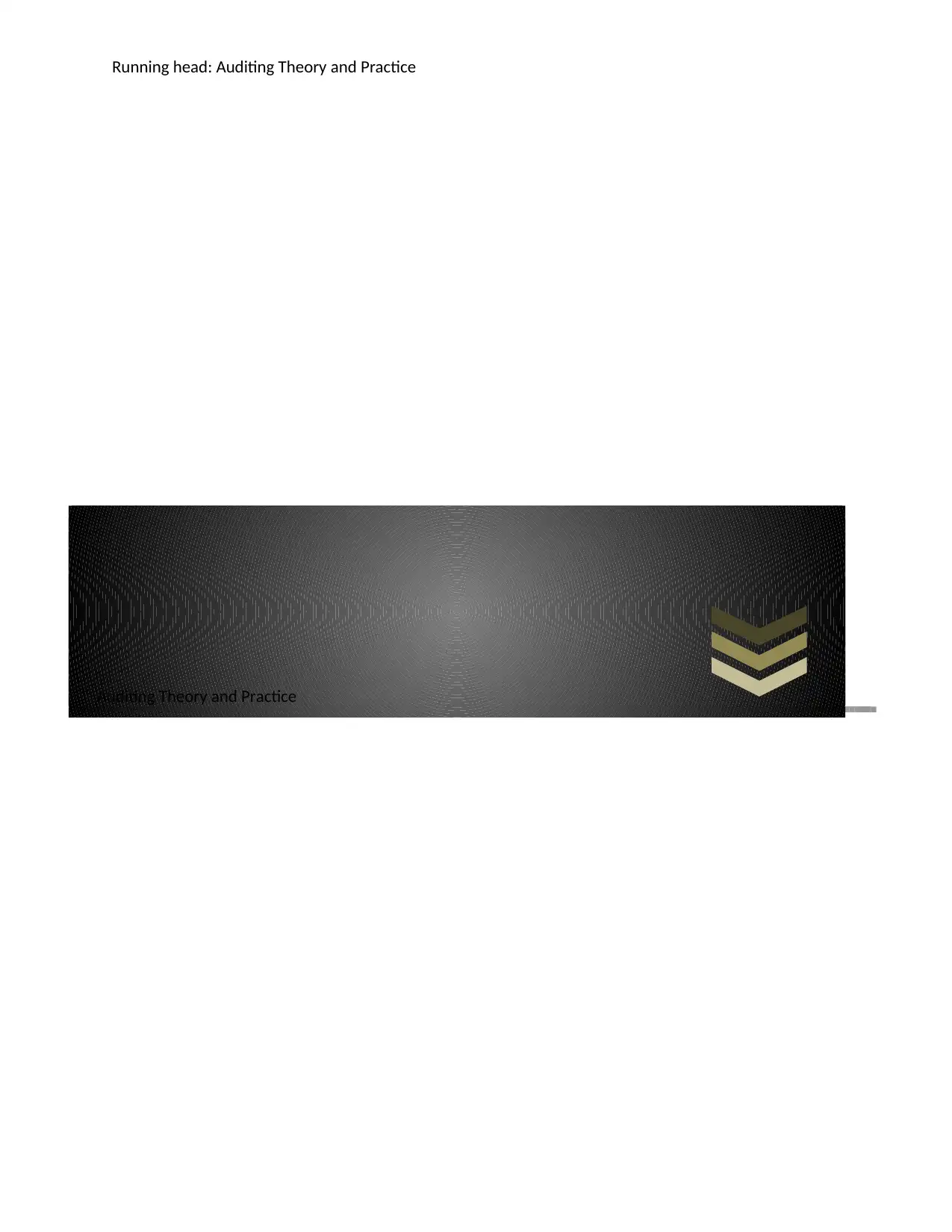
Auditing Theory and Practice
Running head: Auditing Theory and Practice
Running head: Auditing Theory and Practice
Paraphrase This Document
Need a fresh take? Get an instant paraphrase of this document with our AI Paraphraser
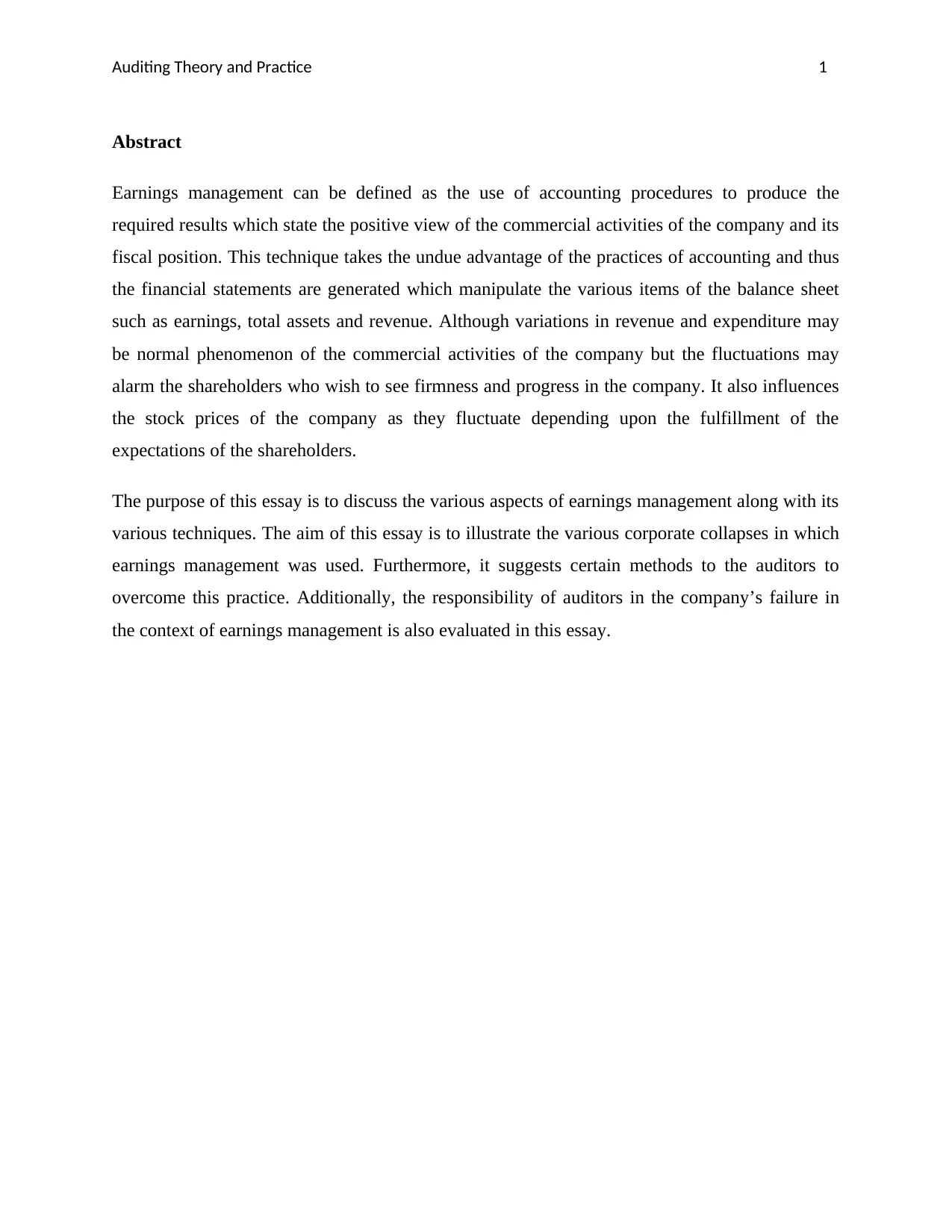
Auditing Theory and Practice 1
Abstract
Earnings management can be defined as the use of accounting procedures to produce the
required results which state the positive view of the commercial activities of the company and its
fiscal position. This technique takes the undue advantage of the practices of accounting and thus
the financial statements are generated which manipulate the various items of the balance sheet
such as earnings, total assets and revenue. Although variations in revenue and expenditure may
be normal phenomenon of the commercial activities of the company but the fluctuations may
alarm the shareholders who wish to see firmness and progress in the company. It also influences
the stock prices of the company as they fluctuate depending upon the fulfillment of the
expectations of the shareholders.
The purpose of this essay is to discuss the various aspects of earnings management along with its
various techniques. The aim of this essay is to illustrate the various corporate collapses in which
earnings management was used. Furthermore, it suggests certain methods to the auditors to
overcome this practice. Additionally, the responsibility of auditors in the company’s failure in
the context of earnings management is also evaluated in this essay.
Abstract
Earnings management can be defined as the use of accounting procedures to produce the
required results which state the positive view of the commercial activities of the company and its
fiscal position. This technique takes the undue advantage of the practices of accounting and thus
the financial statements are generated which manipulate the various items of the balance sheet
such as earnings, total assets and revenue. Although variations in revenue and expenditure may
be normal phenomenon of the commercial activities of the company but the fluctuations may
alarm the shareholders who wish to see firmness and progress in the company. It also influences
the stock prices of the company as they fluctuate depending upon the fulfillment of the
expectations of the shareholders.
The purpose of this essay is to discuss the various aspects of earnings management along with its
various techniques. The aim of this essay is to illustrate the various corporate collapses in which
earnings management was used. Furthermore, it suggests certain methods to the auditors to
overcome this practice. Additionally, the responsibility of auditors in the company’s failure in
the context of earnings management is also evaluated in this essay.
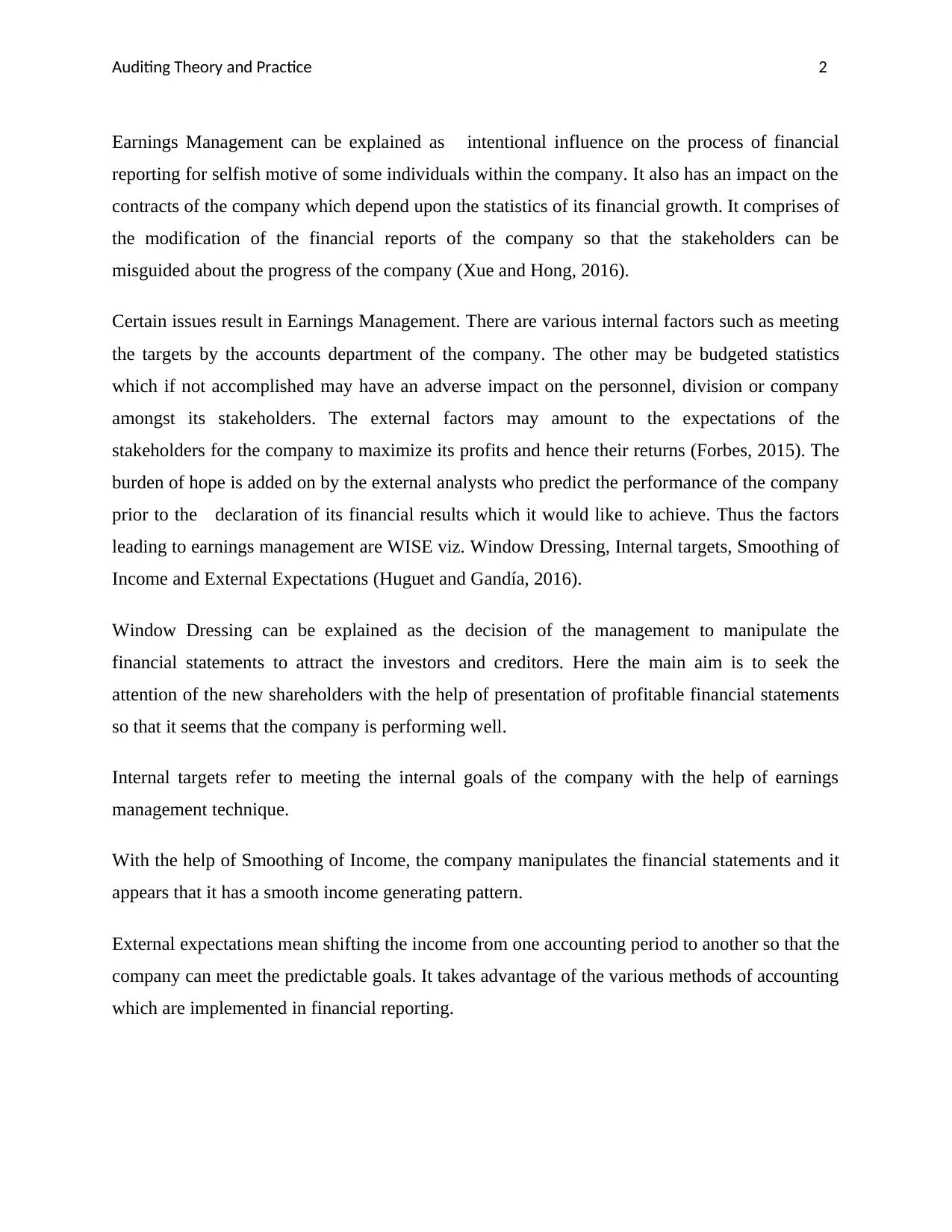
Auditing Theory and Practice 2
Earnings Management can be explained as intentional influence on the process of financial
reporting for selfish motive of some individuals within the company. It also has an impact on the
contracts of the company which depend upon the statistics of its financial growth. It comprises of
the modification of the financial reports of the company so that the stakeholders can be
misguided about the progress of the company (Xue and Hong, 2016).
Certain issues result in Earnings Management. There are various internal factors such as meeting
the targets by the accounts department of the company. The other may be budgeted statistics
which if not accomplished may have an adverse impact on the personnel, division or company
amongst its stakeholders. The external factors may amount to the expectations of the
stakeholders for the company to maximize its profits and hence their returns (Forbes, 2015). The
burden of hope is added on by the external analysts who predict the performance of the company
prior to the declaration of its financial results which it would like to achieve. Thus the factors
leading to earnings management are WISE viz. Window Dressing, Internal targets, Smoothing of
Income and External Expectations (Huguet and Gandía, 2016).
Window Dressing can be explained as the decision of the management to manipulate the
financial statements to attract the investors and creditors. Here the main aim is to seek the
attention of the new shareholders with the help of presentation of profitable financial statements
so that it seems that the company is performing well.
Internal targets refer to meeting the internal goals of the company with the help of earnings
management technique.
With the help of Smoothing of Income, the company manipulates the financial statements and it
appears that it has a smooth income generating pattern.
External expectations mean shifting the income from one accounting period to another so that the
company can meet the predictable goals. It takes advantage of the various methods of accounting
which are implemented in financial reporting.
Earnings Management can be explained as intentional influence on the process of financial
reporting for selfish motive of some individuals within the company. It also has an impact on the
contracts of the company which depend upon the statistics of its financial growth. It comprises of
the modification of the financial reports of the company so that the stakeholders can be
misguided about the progress of the company (Xue and Hong, 2016).
Certain issues result in Earnings Management. There are various internal factors such as meeting
the targets by the accounts department of the company. The other may be budgeted statistics
which if not accomplished may have an adverse impact on the personnel, division or company
amongst its stakeholders. The external factors may amount to the expectations of the
stakeholders for the company to maximize its profits and hence their returns (Forbes, 2015). The
burden of hope is added on by the external analysts who predict the performance of the company
prior to the declaration of its financial results which it would like to achieve. Thus the factors
leading to earnings management are WISE viz. Window Dressing, Internal targets, Smoothing of
Income and External Expectations (Huguet and Gandía, 2016).
Window Dressing can be explained as the decision of the management to manipulate the
financial statements to attract the investors and creditors. Here the main aim is to seek the
attention of the new shareholders with the help of presentation of profitable financial statements
so that it seems that the company is performing well.
Internal targets refer to meeting the internal goals of the company with the help of earnings
management technique.
With the help of Smoothing of Income, the company manipulates the financial statements and it
appears that it has a smooth income generating pattern.
External expectations mean shifting the income from one accounting period to another so that the
company can meet the predictable goals. It takes advantage of the various methods of accounting
which are implemented in financial reporting.
⊘ This is a preview!⊘
Do you want full access?
Subscribe today to unlock all pages.

Trusted by 1+ million students worldwide
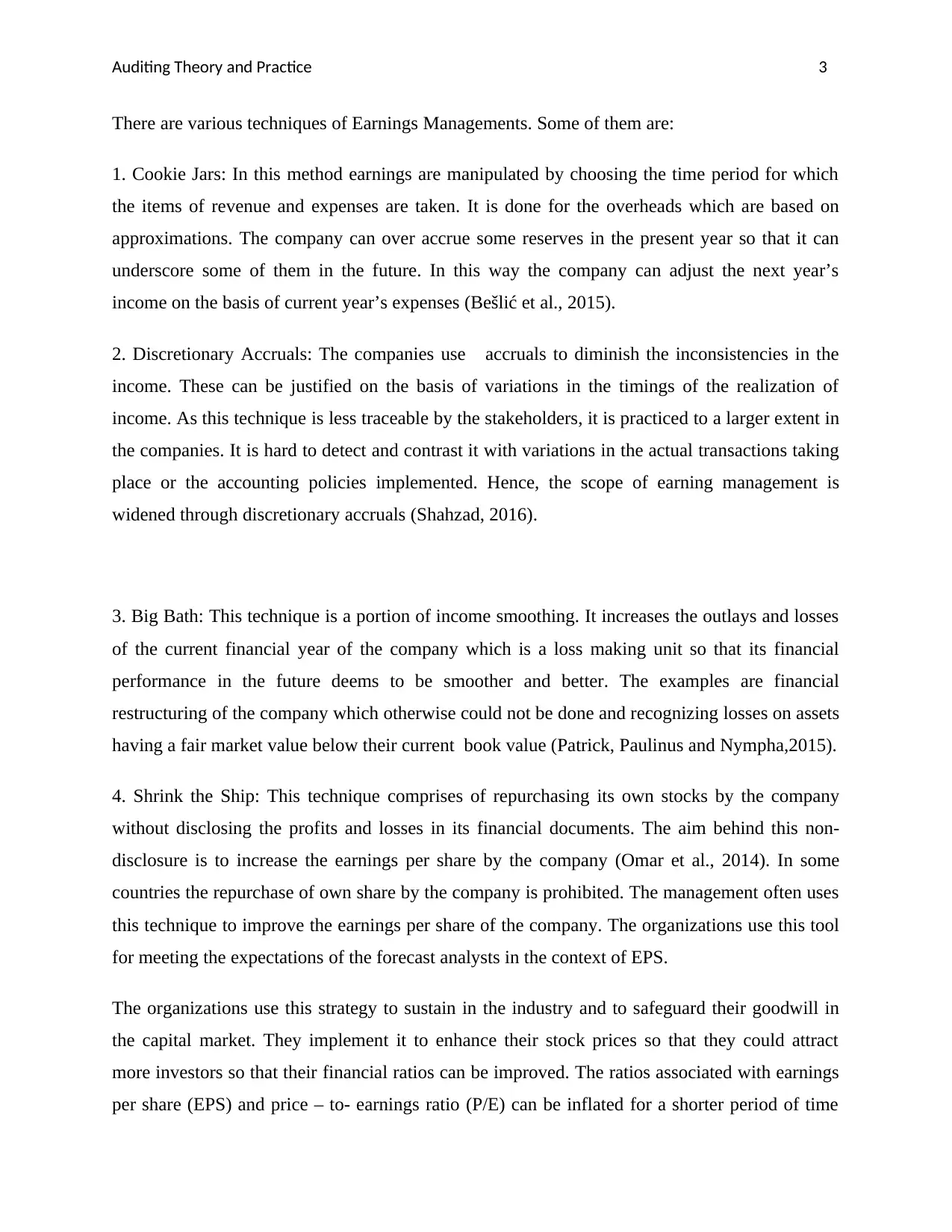
Auditing Theory and Practice 3
There are various techniques of Earnings Managements. Some of them are:
1. Cookie Jars: In this method earnings are manipulated by choosing the time period for which
the items of revenue and expenses are taken. It is done for the overheads which are based on
approximations. The company can over accrue some reserves in the present year so that it can
underscore some of them in the future. In this way the company can adjust the next year’s
income on the basis of current year’s expenses (Bešlić et al., 2015).
2. Discretionary Accruals: The companies use accruals to diminish the inconsistencies in the
income. These can be justified on the basis of variations in the timings of the realization of
income. As this technique is less traceable by the stakeholders, it is practiced to a larger extent in
the companies. It is hard to detect and contrast it with variations in the actual transactions taking
place or the accounting policies implemented. Hence, the scope of earning management is
widened through discretionary accruals (Shahzad, 2016).
3. Big Bath: This technique is a portion of income smoothing. It increases the outlays and losses
of the current financial year of the company which is a loss making unit so that its financial
performance in the future deems to be smoother and better. The examples are financial
restructuring of the company which otherwise could not be done and recognizing losses on assets
having a fair market value below their current book value (Patrick, Paulinus and Nympha,2015).
4. Shrink the Ship: This technique comprises of repurchasing its own stocks by the company
without disclosing the profits and losses in its financial documents. The aim behind this non-
disclosure is to increase the earnings per share by the company (Omar et al., 2014). In some
countries the repurchase of own share by the company is prohibited. The management often uses
this technique to improve the earnings per share of the company. The organizations use this tool
for meeting the expectations of the forecast analysts in the context of EPS.
The organizations use this strategy to sustain in the industry and to safeguard their goodwill in
the capital market. They implement it to enhance their stock prices so that they could attract
more investors so that their financial ratios can be improved. The ratios associated with earnings
per share (EPS) and price – to- earnings ratio (P/E) can be inflated for a shorter period of time
There are various techniques of Earnings Managements. Some of them are:
1. Cookie Jars: In this method earnings are manipulated by choosing the time period for which
the items of revenue and expenses are taken. It is done for the overheads which are based on
approximations. The company can over accrue some reserves in the present year so that it can
underscore some of them in the future. In this way the company can adjust the next year’s
income on the basis of current year’s expenses (Bešlić et al., 2015).
2. Discretionary Accruals: The companies use accruals to diminish the inconsistencies in the
income. These can be justified on the basis of variations in the timings of the realization of
income. As this technique is less traceable by the stakeholders, it is practiced to a larger extent in
the companies. It is hard to detect and contrast it with variations in the actual transactions taking
place or the accounting policies implemented. Hence, the scope of earning management is
widened through discretionary accruals (Shahzad, 2016).
3. Big Bath: This technique is a portion of income smoothing. It increases the outlays and losses
of the current financial year of the company which is a loss making unit so that its financial
performance in the future deems to be smoother and better. The examples are financial
restructuring of the company which otherwise could not be done and recognizing losses on assets
having a fair market value below their current book value (Patrick, Paulinus and Nympha,2015).
4. Shrink the Ship: This technique comprises of repurchasing its own stocks by the company
without disclosing the profits and losses in its financial documents. The aim behind this non-
disclosure is to increase the earnings per share by the company (Omar et al., 2014). In some
countries the repurchase of own share by the company is prohibited. The management often uses
this technique to improve the earnings per share of the company. The organizations use this tool
for meeting the expectations of the forecast analysts in the context of EPS.
The organizations use this strategy to sustain in the industry and to safeguard their goodwill in
the capital market. They implement it to enhance their stock prices so that they could attract
more investors so that their financial ratios can be improved. The ratios associated with earnings
per share (EPS) and price – to- earnings ratio (P/E) can be inflated for a shorter period of time
Paraphrase This Document
Need a fresh take? Get an instant paraphrase of this document with our AI Paraphraser
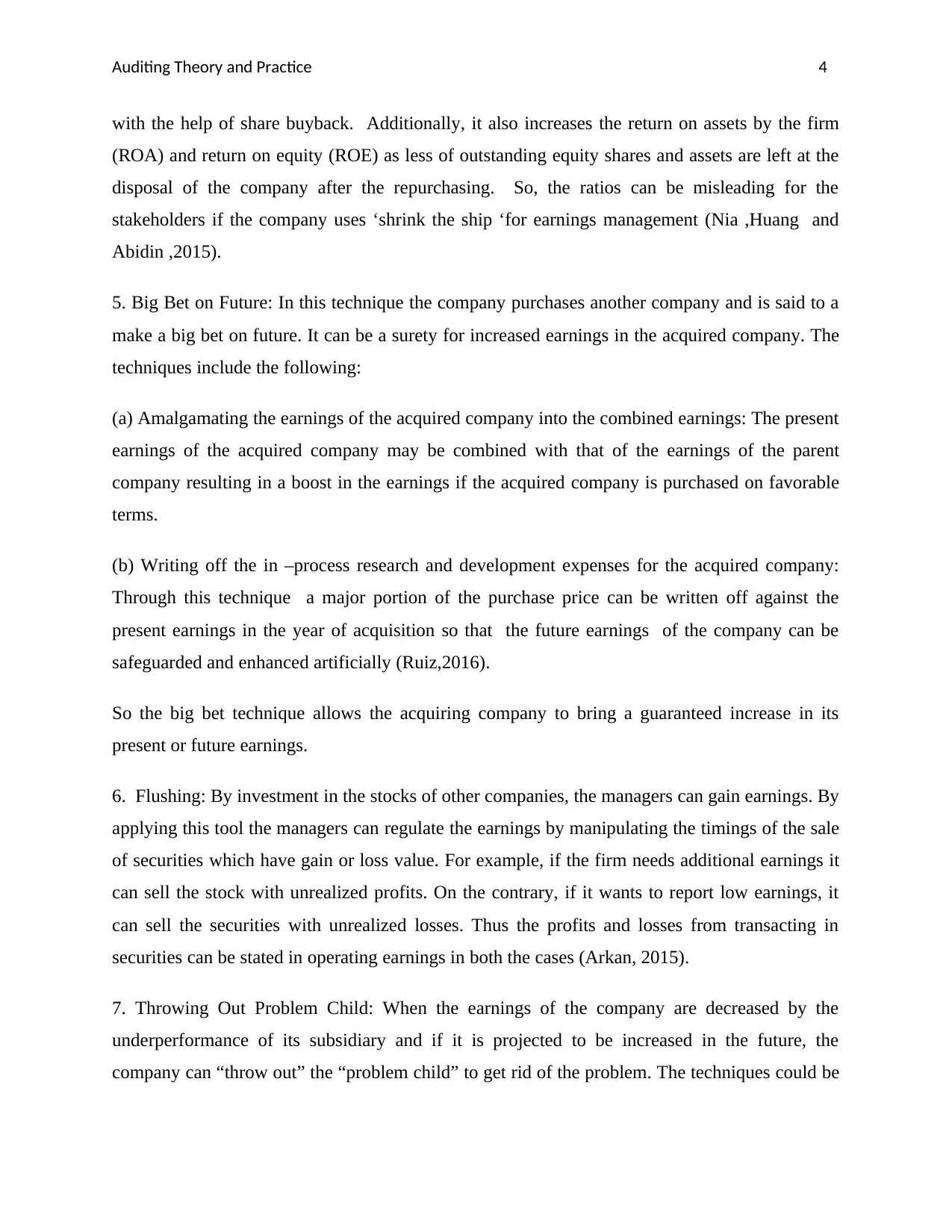
Auditing Theory and Practice 4
with the help of share buyback. Additionally, it also increases the return on assets by the firm
(ROA) and return on equity (ROE) as less of outstanding equity shares and assets are left at the
disposal of the company after the repurchasing. So, the ratios can be misleading for the
stakeholders if the company uses ‘shrink the ship ‘for earnings management (Nia ,Huang and
Abidin ,2015).
5. Big Bet on Future: In this technique the company purchases another company and is said to a
make a big bet on future. It can be a surety for increased earnings in the acquired company. The
techniques include the following:
(a) Amalgamating the earnings of the acquired company into the combined earnings: The present
earnings of the acquired company may be combined with that of the earnings of the parent
company resulting in a boost in the earnings if the acquired company is purchased on favorable
terms.
(b) Writing off the in –process research and development expenses for the acquired company:
Through this technique a major portion of the purchase price can be written off against the
present earnings in the year of acquisition so that the future earnings of the company can be
safeguarded and enhanced artificially (Ruiz,2016).
So the big bet technique allows the acquiring company to bring a guaranteed increase in its
present or future earnings.
6. Flushing: By investment in the stocks of other companies, the managers can gain earnings. By
applying this tool the managers can regulate the earnings by manipulating the timings of the sale
of securities which have gain or loss value. For example, if the firm needs additional earnings it
can sell the stock with unrealized profits. On the contrary, if it wants to report low earnings, it
can sell the securities with unrealized losses. Thus the profits and losses from transacting in
securities can be stated in operating earnings in both the cases (Arkan, 2015).
7. Throwing Out Problem Child: When the earnings of the company are decreased by the
underperformance of its subsidiary and if it is projected to be increased in the future, the
company can “throw out” the “problem child” to get rid of the problem. The techniques could be
with the help of share buyback. Additionally, it also increases the return on assets by the firm
(ROA) and return on equity (ROE) as less of outstanding equity shares and assets are left at the
disposal of the company after the repurchasing. So, the ratios can be misleading for the
stakeholders if the company uses ‘shrink the ship ‘for earnings management (Nia ,Huang and
Abidin ,2015).
5. Big Bet on Future: In this technique the company purchases another company and is said to a
make a big bet on future. It can be a surety for increased earnings in the acquired company. The
techniques include the following:
(a) Amalgamating the earnings of the acquired company into the combined earnings: The present
earnings of the acquired company may be combined with that of the earnings of the parent
company resulting in a boost in the earnings if the acquired company is purchased on favorable
terms.
(b) Writing off the in –process research and development expenses for the acquired company:
Through this technique a major portion of the purchase price can be written off against the
present earnings in the year of acquisition so that the future earnings of the company can be
safeguarded and enhanced artificially (Ruiz,2016).
So the big bet technique allows the acquiring company to bring a guaranteed increase in its
present or future earnings.
6. Flushing: By investment in the stocks of other companies, the managers can gain earnings. By
applying this tool the managers can regulate the earnings by manipulating the timings of the sale
of securities which have gain or loss value. For example, if the firm needs additional earnings it
can sell the stock with unrealized profits. On the contrary, if it wants to report low earnings, it
can sell the securities with unrealized losses. Thus the profits and losses from transacting in
securities can be stated in operating earnings in both the cases (Arkan, 2015).
7. Throwing Out Problem Child: When the earnings of the company are decreased by the
underperformance of its subsidiary and if it is projected to be increased in the future, the
company can “throw out” the “problem child” to get rid of the problem. The techniques could be
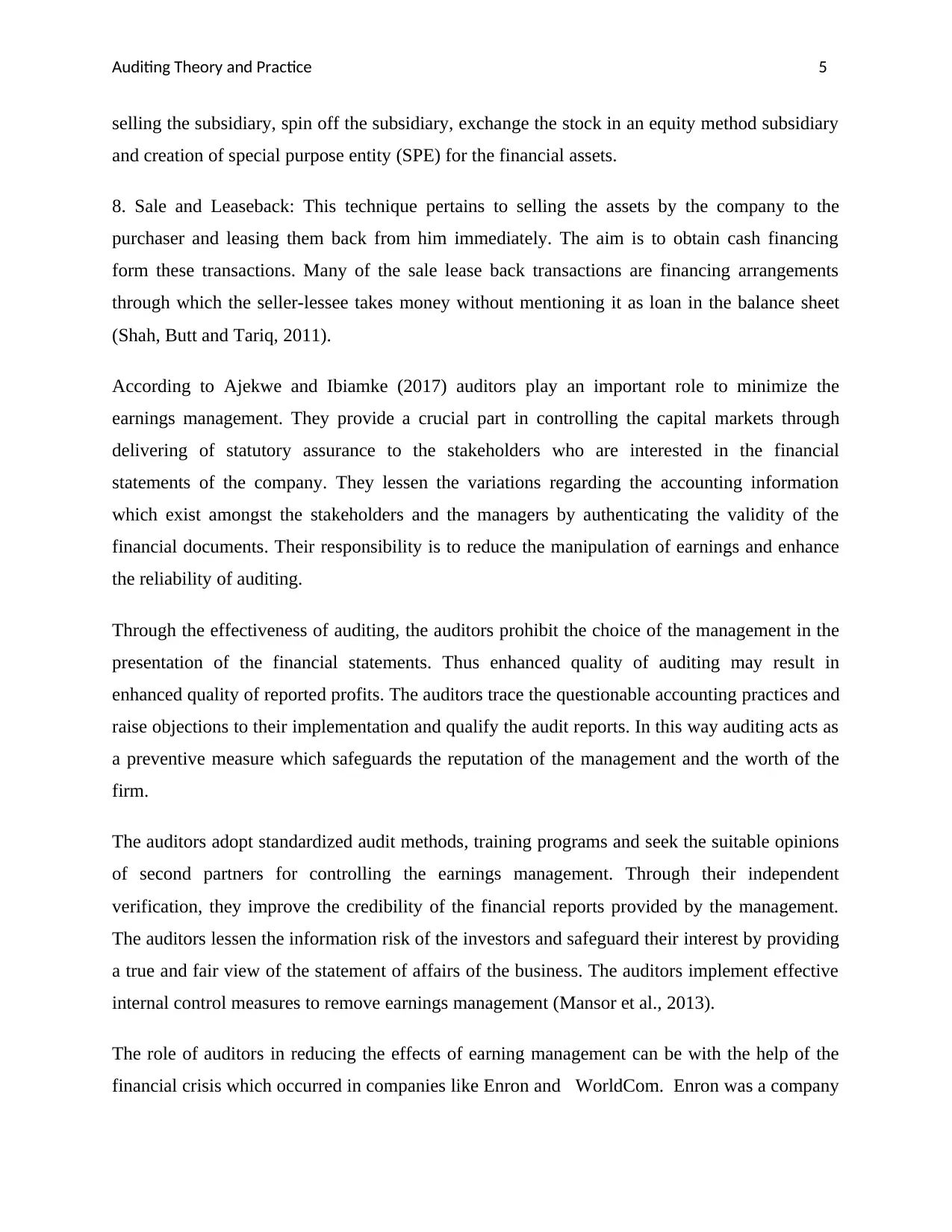
Auditing Theory and Practice 5
selling the subsidiary, spin off the subsidiary, exchange the stock in an equity method subsidiary
and creation of special purpose entity (SPE) for the financial assets.
8. Sale and Leaseback: This technique pertains to selling the assets by the company to the
purchaser and leasing them back from him immediately. The aim is to obtain cash financing
form these transactions. Many of the sale lease back transactions are financing arrangements
through which the seller-lessee takes money without mentioning it as loan in the balance sheet
(Shah, Butt and Tariq, 2011).
According to Ajekwe and Ibiamke (2017) auditors play an important role to minimize the
earnings management. They provide a crucial part in controlling the capital markets through
delivering of statutory assurance to the stakeholders who are interested in the financial
statements of the company. They lessen the variations regarding the accounting information
which exist amongst the stakeholders and the managers by authenticating the validity of the
financial documents. Their responsibility is to reduce the manipulation of earnings and enhance
the reliability of auditing.
Through the effectiveness of auditing, the auditors prohibit the choice of the management in the
presentation of the financial statements. Thus enhanced quality of auditing may result in
enhanced quality of reported profits. The auditors trace the questionable accounting practices and
raise objections to their implementation and qualify the audit reports. In this way auditing acts as
a preventive measure which safeguards the reputation of the management and the worth of the
firm.
The auditors adopt standardized audit methods, training programs and seek the suitable opinions
of second partners for controlling the earnings management. Through their independent
verification, they improve the credibility of the financial reports provided by the management.
The auditors lessen the information risk of the investors and safeguard their interest by providing
a true and fair view of the statement of affairs of the business. The auditors implement effective
internal control measures to remove earnings management (Mansor et al., 2013).
The role of auditors in reducing the effects of earning management can be with the help of the
financial crisis which occurred in companies like Enron and WorldCom. Enron was a company
selling the subsidiary, spin off the subsidiary, exchange the stock in an equity method subsidiary
and creation of special purpose entity (SPE) for the financial assets.
8. Sale and Leaseback: This technique pertains to selling the assets by the company to the
purchaser and leasing them back from him immediately. The aim is to obtain cash financing
form these transactions. Many of the sale lease back transactions are financing arrangements
through which the seller-lessee takes money without mentioning it as loan in the balance sheet
(Shah, Butt and Tariq, 2011).
According to Ajekwe and Ibiamke (2017) auditors play an important role to minimize the
earnings management. They provide a crucial part in controlling the capital markets through
delivering of statutory assurance to the stakeholders who are interested in the financial
statements of the company. They lessen the variations regarding the accounting information
which exist amongst the stakeholders and the managers by authenticating the validity of the
financial documents. Their responsibility is to reduce the manipulation of earnings and enhance
the reliability of auditing.
Through the effectiveness of auditing, the auditors prohibit the choice of the management in the
presentation of the financial statements. Thus enhanced quality of auditing may result in
enhanced quality of reported profits. The auditors trace the questionable accounting practices and
raise objections to their implementation and qualify the audit reports. In this way auditing acts as
a preventive measure which safeguards the reputation of the management and the worth of the
firm.
The auditors adopt standardized audit methods, training programs and seek the suitable opinions
of second partners for controlling the earnings management. Through their independent
verification, they improve the credibility of the financial reports provided by the management.
The auditors lessen the information risk of the investors and safeguard their interest by providing
a true and fair view of the statement of affairs of the business. The auditors implement effective
internal control measures to remove earnings management (Mansor et al., 2013).
The role of auditors in reducing the effects of earning management can be with the help of the
financial crisis which occurred in companies like Enron and WorldCom. Enron was a company
⊘ This is a preview!⊘
Do you want full access?
Subscribe today to unlock all pages.

Trusted by 1+ million students worldwide
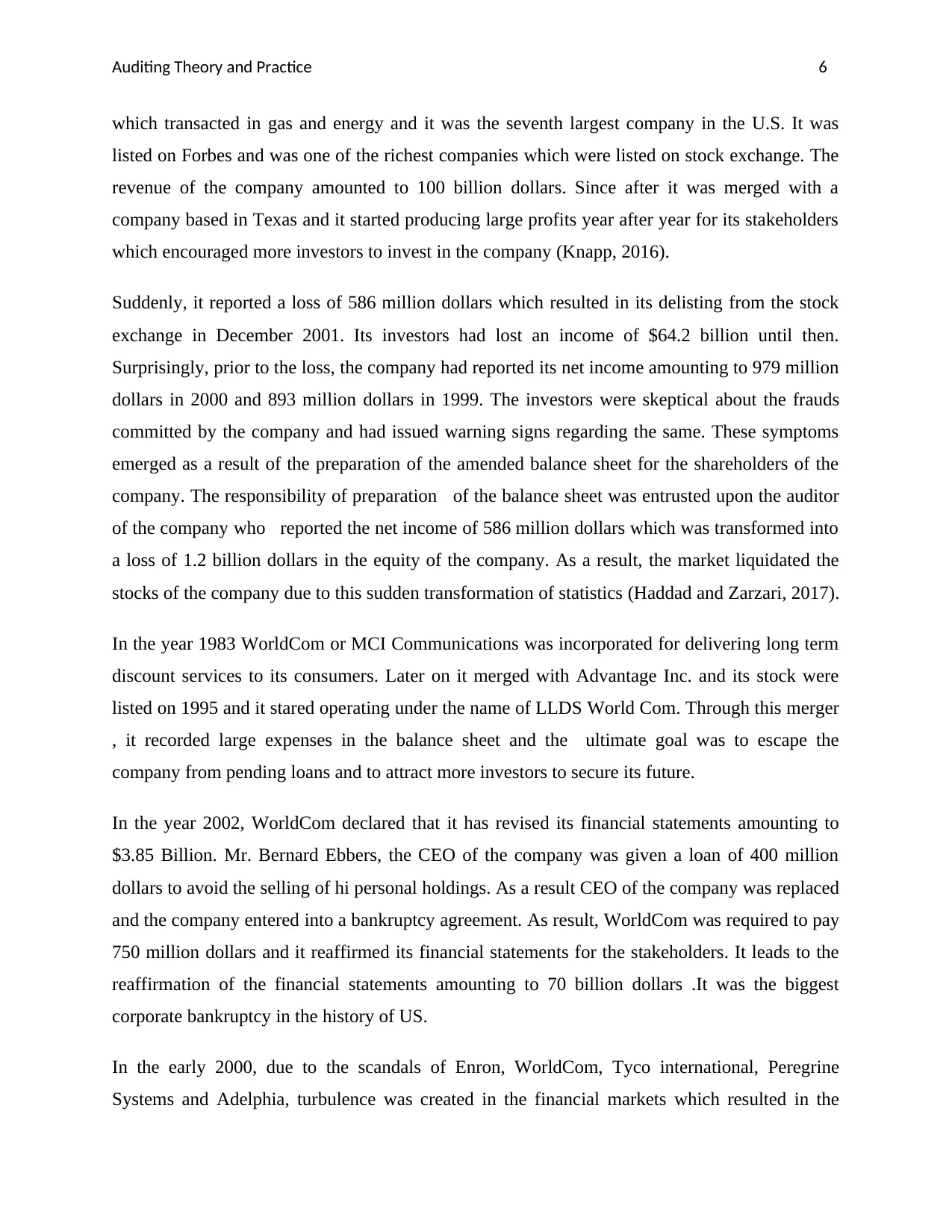
Auditing Theory and Practice 6
which transacted in gas and energy and it was the seventh largest company in the U.S. It was
listed on Forbes and was one of the richest companies which were listed on stock exchange. The
revenue of the company amounted to 100 billion dollars. Since after it was merged with a
company based in Texas and it started producing large profits year after year for its stakeholders
which encouraged more investors to invest in the company (Knapp, 2016).
Suddenly, it reported a loss of 586 million dollars which resulted in its delisting from the stock
exchange in December 2001. Its investors had lost an income of $64.2 billion until then.
Surprisingly, prior to the loss, the company had reported its net income amounting to 979 million
dollars in 2000 and 893 million dollars in 1999. The investors were skeptical about the frauds
committed by the company and had issued warning signs regarding the same. These symptoms
emerged as a result of the preparation of the amended balance sheet for the shareholders of the
company. The responsibility of preparation of the balance sheet was entrusted upon the auditor
of the company who reported the net income of 586 million dollars which was transformed into
a loss of 1.2 billion dollars in the equity of the company. As a result, the market liquidated the
stocks of the company due to this sudden transformation of statistics (Haddad and Zarzari, 2017).
In the year 1983 WorldCom or MCI Communications was incorporated for delivering long term
discount services to its consumers. Later on it merged with Advantage Inc. and its stock were
listed on 1995 and it stared operating under the name of LLDS World Com. Through this merger
, it recorded large expenses in the balance sheet and the ultimate goal was to escape the
company from pending loans and to attract more investors to secure its future.
In the year 2002, WorldCom declared that it has revised its financial statements amounting to
$3.85 Billion. Mr. Bernard Ebbers, the CEO of the company was given a loan of 400 million
dollars to avoid the selling of hi personal holdings. As a result CEO of the company was replaced
and the company entered into a bankruptcy agreement. As result, WorldCom was required to pay
750 million dollars and it reaffirmed its financial statements for the stakeholders. It leads to the
reaffirmation of the financial statements amounting to 70 billion dollars .It was the biggest
corporate bankruptcy in the history of US.
In the early 2000, due to the scandals of Enron, WorldCom, Tyco international, Peregrine
Systems and Adelphia, turbulence was created in the financial markets which resulted in the
which transacted in gas and energy and it was the seventh largest company in the U.S. It was
listed on Forbes and was one of the richest companies which were listed on stock exchange. The
revenue of the company amounted to 100 billion dollars. Since after it was merged with a
company based in Texas and it started producing large profits year after year for its stakeholders
which encouraged more investors to invest in the company (Knapp, 2016).
Suddenly, it reported a loss of 586 million dollars which resulted in its delisting from the stock
exchange in December 2001. Its investors had lost an income of $64.2 billion until then.
Surprisingly, prior to the loss, the company had reported its net income amounting to 979 million
dollars in 2000 and 893 million dollars in 1999. The investors were skeptical about the frauds
committed by the company and had issued warning signs regarding the same. These symptoms
emerged as a result of the preparation of the amended balance sheet for the shareholders of the
company. The responsibility of preparation of the balance sheet was entrusted upon the auditor
of the company who reported the net income of 586 million dollars which was transformed into
a loss of 1.2 billion dollars in the equity of the company. As a result, the market liquidated the
stocks of the company due to this sudden transformation of statistics (Haddad and Zarzari, 2017).
In the year 1983 WorldCom or MCI Communications was incorporated for delivering long term
discount services to its consumers. Later on it merged with Advantage Inc. and its stock were
listed on 1995 and it stared operating under the name of LLDS World Com. Through this merger
, it recorded large expenses in the balance sheet and the ultimate goal was to escape the
company from pending loans and to attract more investors to secure its future.
In the year 2002, WorldCom declared that it has revised its financial statements amounting to
$3.85 Billion. Mr. Bernard Ebbers, the CEO of the company was given a loan of 400 million
dollars to avoid the selling of hi personal holdings. As a result CEO of the company was replaced
and the company entered into a bankruptcy agreement. As result, WorldCom was required to pay
750 million dollars and it reaffirmed its financial statements for the stakeholders. It leads to the
reaffirmation of the financial statements amounting to 70 billion dollars .It was the biggest
corporate bankruptcy in the history of US.
In the early 2000, due to the scandals of Enron, WorldCom, Tyco international, Peregrine
Systems and Adelphia, turbulence was created in the financial markets which resulted in the
Paraphrase This Document
Need a fresh take? Get an instant paraphrase of this document with our AI Paraphraser
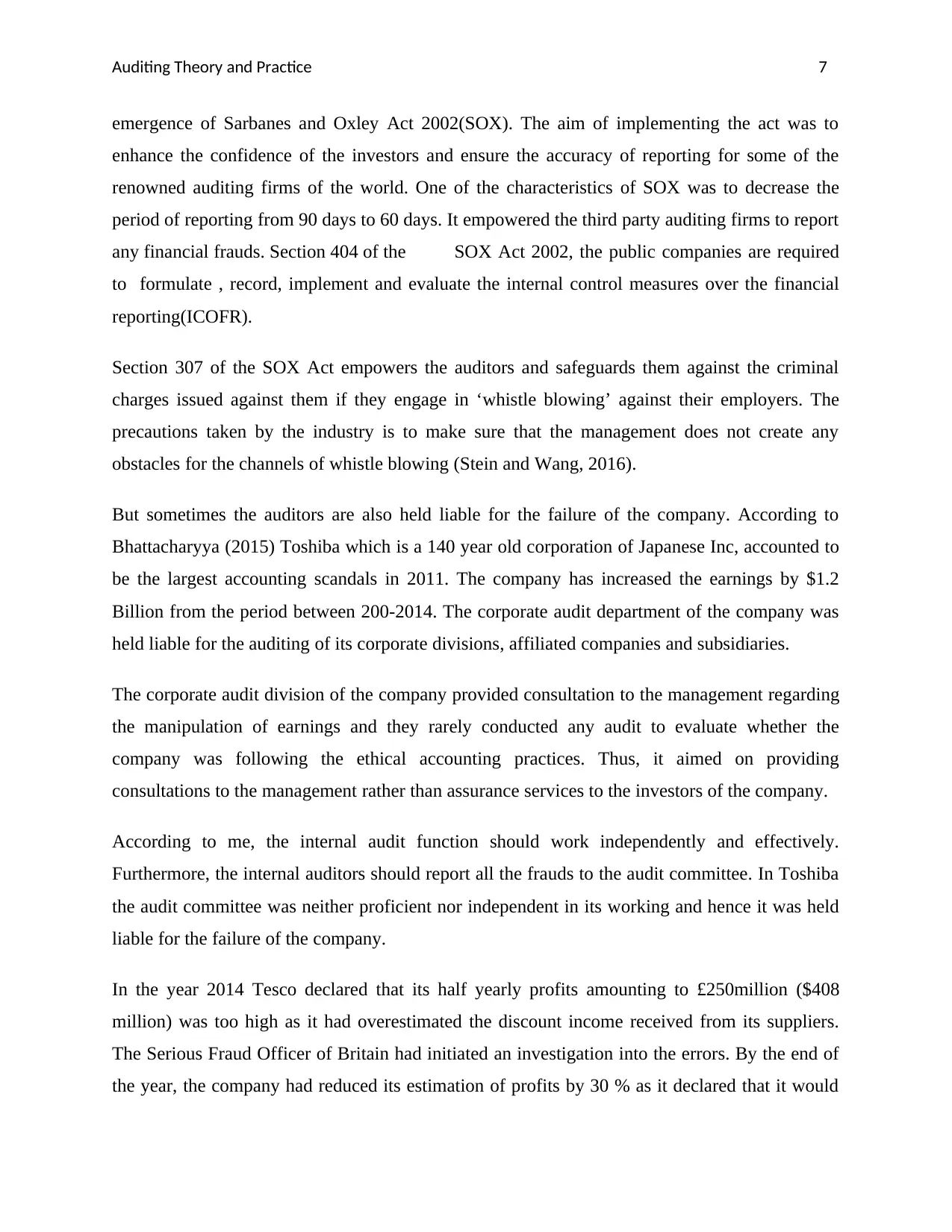
Auditing Theory and Practice 7
emergence of Sarbanes and Oxley Act 2002(SOX). The aim of implementing the act was to
enhance the confidence of the investors and ensure the accuracy of reporting for some of the
renowned auditing firms of the world. One of the characteristics of SOX was to decrease the
period of reporting from 90 days to 60 days. It empowered the third party auditing firms to report
any financial frauds. Section 404 of the SOX Act 2002, the public companies are required
to formulate , record, implement and evaluate the internal control measures over the financial
reporting(ICOFR).
Section 307 of the SOX Act empowers the auditors and safeguards them against the criminal
charges issued against them if they engage in ‘whistle blowing’ against their employers. The
precautions taken by the industry is to make sure that the management does not create any
obstacles for the channels of whistle blowing (Stein and Wang, 2016).
But sometimes the auditors are also held liable for the failure of the company. According to
Bhattacharyya (2015) Toshiba which is a 140 year old corporation of Japanese Inc, accounted to
be the largest accounting scandals in 2011. The company has increased the earnings by $1.2
Billion from the period between 200-2014. The corporate audit department of the company was
held liable for the auditing of its corporate divisions, affiliated companies and subsidiaries.
The corporate audit division of the company provided consultation to the management regarding
the manipulation of earnings and they rarely conducted any audit to evaluate whether the
company was following the ethical accounting practices. Thus, it aimed on providing
consultations to the management rather than assurance services to the investors of the company.
According to me, the internal audit function should work independently and effectively.
Furthermore, the internal auditors should report all the frauds to the audit committee. In Toshiba
the audit committee was neither proficient nor independent in its working and hence it was held
liable for the failure of the company.
In the year 2014 Tesco declared that its half yearly profits amounting to £250million ($408
million) was too high as it had overestimated the discount income received from its suppliers.
The Serious Fraud Officer of Britain had initiated an investigation into the errors. By the end of
the year, the company had reduced its estimation of profits by 30 % as it declared that it would
emergence of Sarbanes and Oxley Act 2002(SOX). The aim of implementing the act was to
enhance the confidence of the investors and ensure the accuracy of reporting for some of the
renowned auditing firms of the world. One of the characteristics of SOX was to decrease the
period of reporting from 90 days to 60 days. It empowered the third party auditing firms to report
any financial frauds. Section 404 of the SOX Act 2002, the public companies are required
to formulate , record, implement and evaluate the internal control measures over the financial
reporting(ICOFR).
Section 307 of the SOX Act empowers the auditors and safeguards them against the criminal
charges issued against them if they engage in ‘whistle blowing’ against their employers. The
precautions taken by the industry is to make sure that the management does not create any
obstacles for the channels of whistle blowing (Stein and Wang, 2016).
But sometimes the auditors are also held liable for the failure of the company. According to
Bhattacharyya (2015) Toshiba which is a 140 year old corporation of Japanese Inc, accounted to
be the largest accounting scandals in 2011. The company has increased the earnings by $1.2
Billion from the period between 200-2014. The corporate audit department of the company was
held liable for the auditing of its corporate divisions, affiliated companies and subsidiaries.
The corporate audit division of the company provided consultation to the management regarding
the manipulation of earnings and they rarely conducted any audit to evaluate whether the
company was following the ethical accounting practices. Thus, it aimed on providing
consultations to the management rather than assurance services to the investors of the company.
According to me, the internal audit function should work independently and effectively.
Furthermore, the internal auditors should report all the frauds to the audit committee. In Toshiba
the audit committee was neither proficient nor independent in its working and hence it was held
liable for the failure of the company.
In the year 2014 Tesco declared that its half yearly profits amounting to £250million ($408
million) was too high as it had overestimated the discount income received from its suppliers.
The Serious Fraud Officer of Britain had initiated an investigation into the errors. By the end of
the year, the company had reduced its estimation of profits by 30 % as it declared that it would
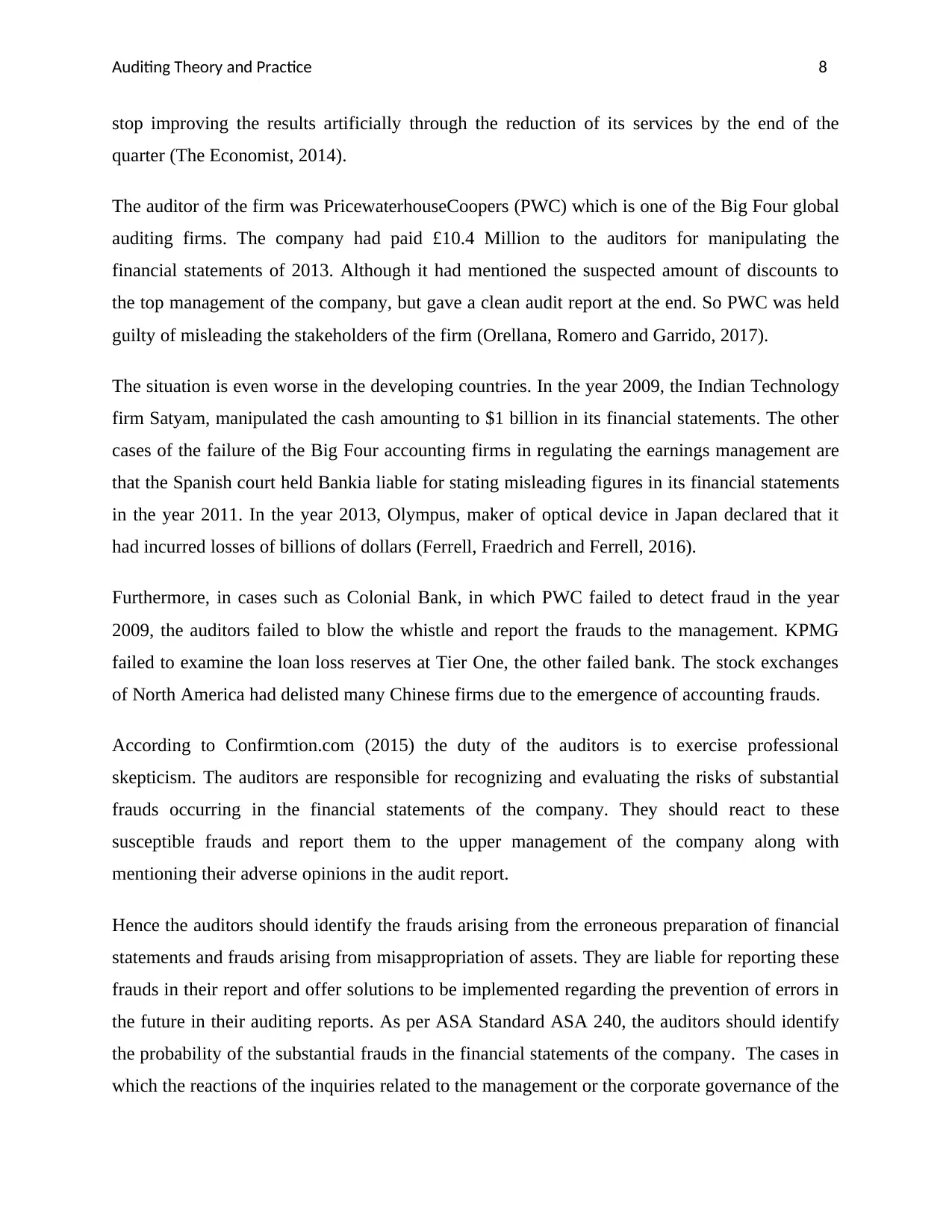
Auditing Theory and Practice 8
stop improving the results artificially through the reduction of its services by the end of the
quarter (The Economist, 2014).
The auditor of the firm was PricewaterhouseCoopers (PWC) which is one of the Big Four global
auditing firms. The company had paid £10.4 Million to the auditors for manipulating the
financial statements of 2013. Although it had mentioned the suspected amount of discounts to
the top management of the company, but gave a clean audit report at the end. So PWC was held
guilty of misleading the stakeholders of the firm (Orellana, Romero and Garrido, 2017).
The situation is even worse in the developing countries. In the year 2009, the Indian Technology
firm Satyam, manipulated the cash amounting to $1 billion in its financial statements. The other
cases of the failure of the Big Four accounting firms in regulating the earnings management are
that the Spanish court held Bankia liable for stating misleading figures in its financial statements
in the year 2011. In the year 2013, Olympus, maker of optical device in Japan declared that it
had incurred losses of billions of dollars (Ferrell, Fraedrich and Ferrell, 2016).
Furthermore, in cases such as Colonial Bank, in which PWC failed to detect fraud in the year
2009, the auditors failed to blow the whistle and report the frauds to the management. KPMG
failed to examine the loan loss reserves at Tier One, the other failed bank. The stock exchanges
of North America had delisted many Chinese firms due to the emergence of accounting frauds.
According to Confirmtion.com (2015) the duty of the auditors is to exercise professional
skepticism. The auditors are responsible for recognizing and evaluating the risks of substantial
frauds occurring in the financial statements of the company. They should react to these
susceptible frauds and report them to the upper management of the company along with
mentioning their adverse opinions in the audit report.
Hence the auditors should identify the frauds arising from the erroneous preparation of financial
statements and frauds arising from misappropriation of assets. They are liable for reporting these
frauds in their report and offer solutions to be implemented regarding the prevention of errors in
the future in their auditing reports. As per ASA Standard ASA 240, the auditors should identify
the probability of the substantial frauds in the financial statements of the company. The cases in
which the reactions of the inquiries related to the management or the corporate governance of the
stop improving the results artificially through the reduction of its services by the end of the
quarter (The Economist, 2014).
The auditor of the firm was PricewaterhouseCoopers (PWC) which is one of the Big Four global
auditing firms. The company had paid £10.4 Million to the auditors for manipulating the
financial statements of 2013. Although it had mentioned the suspected amount of discounts to
the top management of the company, but gave a clean audit report at the end. So PWC was held
guilty of misleading the stakeholders of the firm (Orellana, Romero and Garrido, 2017).
The situation is even worse in the developing countries. In the year 2009, the Indian Technology
firm Satyam, manipulated the cash amounting to $1 billion in its financial statements. The other
cases of the failure of the Big Four accounting firms in regulating the earnings management are
that the Spanish court held Bankia liable for stating misleading figures in its financial statements
in the year 2011. In the year 2013, Olympus, maker of optical device in Japan declared that it
had incurred losses of billions of dollars (Ferrell, Fraedrich and Ferrell, 2016).
Furthermore, in cases such as Colonial Bank, in which PWC failed to detect fraud in the year
2009, the auditors failed to blow the whistle and report the frauds to the management. KPMG
failed to examine the loan loss reserves at Tier One, the other failed bank. The stock exchanges
of North America had delisted many Chinese firms due to the emergence of accounting frauds.
According to Confirmtion.com (2015) the duty of the auditors is to exercise professional
skepticism. The auditors are responsible for recognizing and evaluating the risks of substantial
frauds occurring in the financial statements of the company. They should react to these
susceptible frauds and report them to the upper management of the company along with
mentioning their adverse opinions in the audit report.
Hence the auditors should identify the frauds arising from the erroneous preparation of financial
statements and frauds arising from misappropriation of assets. They are liable for reporting these
frauds in their report and offer solutions to be implemented regarding the prevention of errors in
the future in their auditing reports. As per ASA Standard ASA 240, the auditors should identify
the probability of the substantial frauds in the financial statements of the company. The cases in
which the reactions of the inquiries related to the management or the corporate governance of the
⊘ This is a preview!⊘
Do you want full access?
Subscribe today to unlock all pages.

Trusted by 1+ million students worldwide
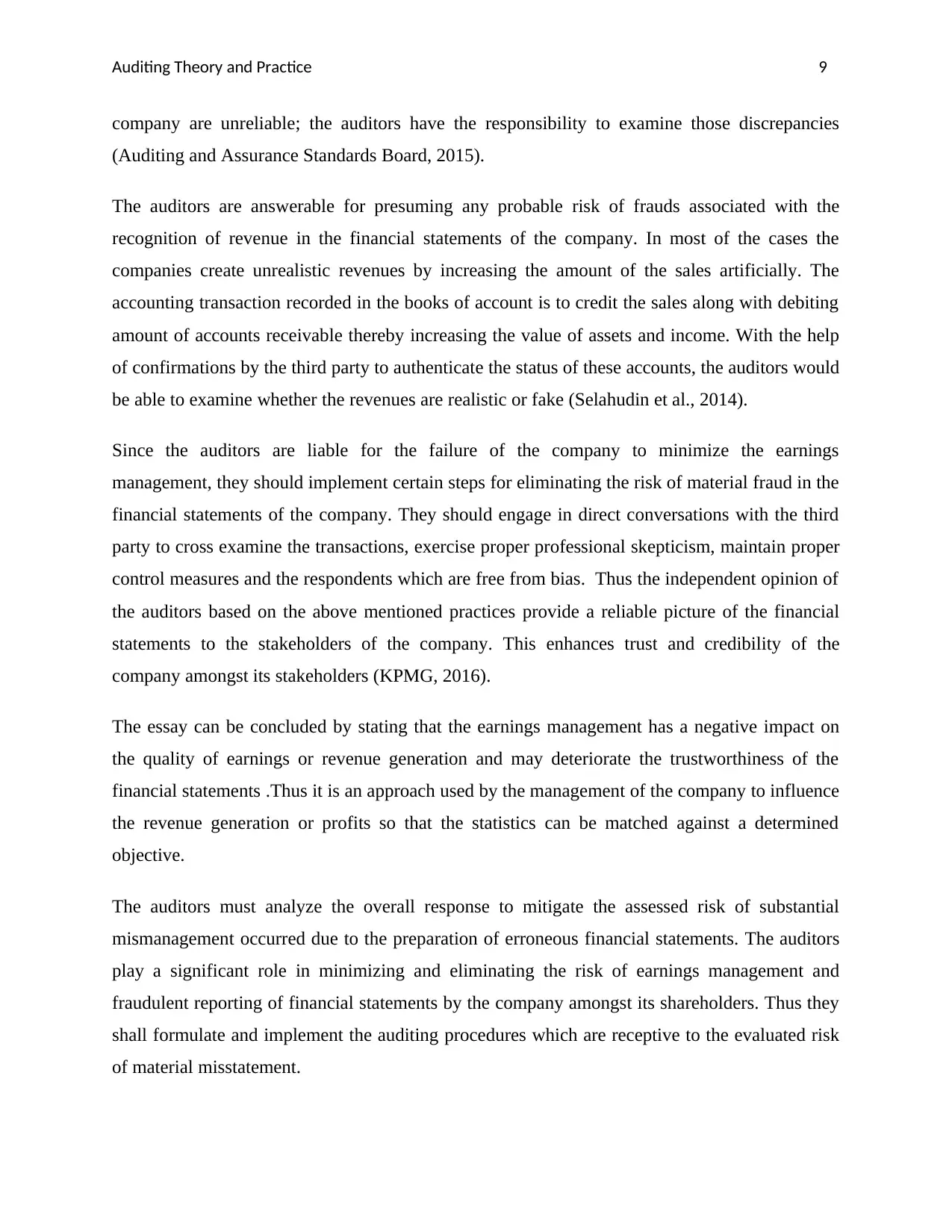
Auditing Theory and Practice 9
company are unreliable; the auditors have the responsibility to examine those discrepancies
(Auditing and Assurance Standards Board, 2015).
The auditors are answerable for presuming any probable risk of frauds associated with the
recognition of revenue in the financial statements of the company. In most of the cases the
companies create unrealistic revenues by increasing the amount of the sales artificially. The
accounting transaction recorded in the books of account is to credit the sales along with debiting
amount of accounts receivable thereby increasing the value of assets and income. With the help
of confirmations by the third party to authenticate the status of these accounts, the auditors would
be able to examine whether the revenues are realistic or fake (Selahudin et al., 2014).
Since the auditors are liable for the failure of the company to minimize the earnings
management, they should implement certain steps for eliminating the risk of material fraud in the
financial statements of the company. They should engage in direct conversations with the third
party to cross examine the transactions, exercise proper professional skepticism, maintain proper
control measures and the respondents which are free from bias. Thus the independent opinion of
the auditors based on the above mentioned practices provide a reliable picture of the financial
statements to the stakeholders of the company. This enhances trust and credibility of the
company amongst its stakeholders (KPMG, 2016).
The essay can be concluded by stating that the earnings management has a negative impact on
the quality of earnings or revenue generation and may deteriorate the trustworthiness of the
financial statements .Thus it is an approach used by the management of the company to influence
the revenue generation or profits so that the statistics can be matched against a determined
objective.
The auditors must analyze the overall response to mitigate the assessed risk of substantial
mismanagement occurred due to the preparation of erroneous financial statements. The auditors
play a significant role in minimizing and eliminating the risk of earnings management and
fraudulent reporting of financial statements by the company amongst its shareholders. Thus they
shall formulate and implement the auditing procedures which are receptive to the evaluated risk
of material misstatement.
company are unreliable; the auditors have the responsibility to examine those discrepancies
(Auditing and Assurance Standards Board, 2015).
The auditors are answerable for presuming any probable risk of frauds associated with the
recognition of revenue in the financial statements of the company. In most of the cases the
companies create unrealistic revenues by increasing the amount of the sales artificially. The
accounting transaction recorded in the books of account is to credit the sales along with debiting
amount of accounts receivable thereby increasing the value of assets and income. With the help
of confirmations by the third party to authenticate the status of these accounts, the auditors would
be able to examine whether the revenues are realistic or fake (Selahudin et al., 2014).
Since the auditors are liable for the failure of the company to minimize the earnings
management, they should implement certain steps for eliminating the risk of material fraud in the
financial statements of the company. They should engage in direct conversations with the third
party to cross examine the transactions, exercise proper professional skepticism, maintain proper
control measures and the respondents which are free from bias. Thus the independent opinion of
the auditors based on the above mentioned practices provide a reliable picture of the financial
statements to the stakeholders of the company. This enhances trust and credibility of the
company amongst its stakeholders (KPMG, 2016).
The essay can be concluded by stating that the earnings management has a negative impact on
the quality of earnings or revenue generation and may deteriorate the trustworthiness of the
financial statements .Thus it is an approach used by the management of the company to influence
the revenue generation or profits so that the statistics can be matched against a determined
objective.
The auditors must analyze the overall response to mitigate the assessed risk of substantial
mismanagement occurred due to the preparation of erroneous financial statements. The auditors
play a significant role in minimizing and eliminating the risk of earnings management and
fraudulent reporting of financial statements by the company amongst its shareholders. Thus they
shall formulate and implement the auditing procedures which are receptive to the evaluated risk
of material misstatement.
Paraphrase This Document
Need a fresh take? Get an instant paraphrase of this document with our AI Paraphraser
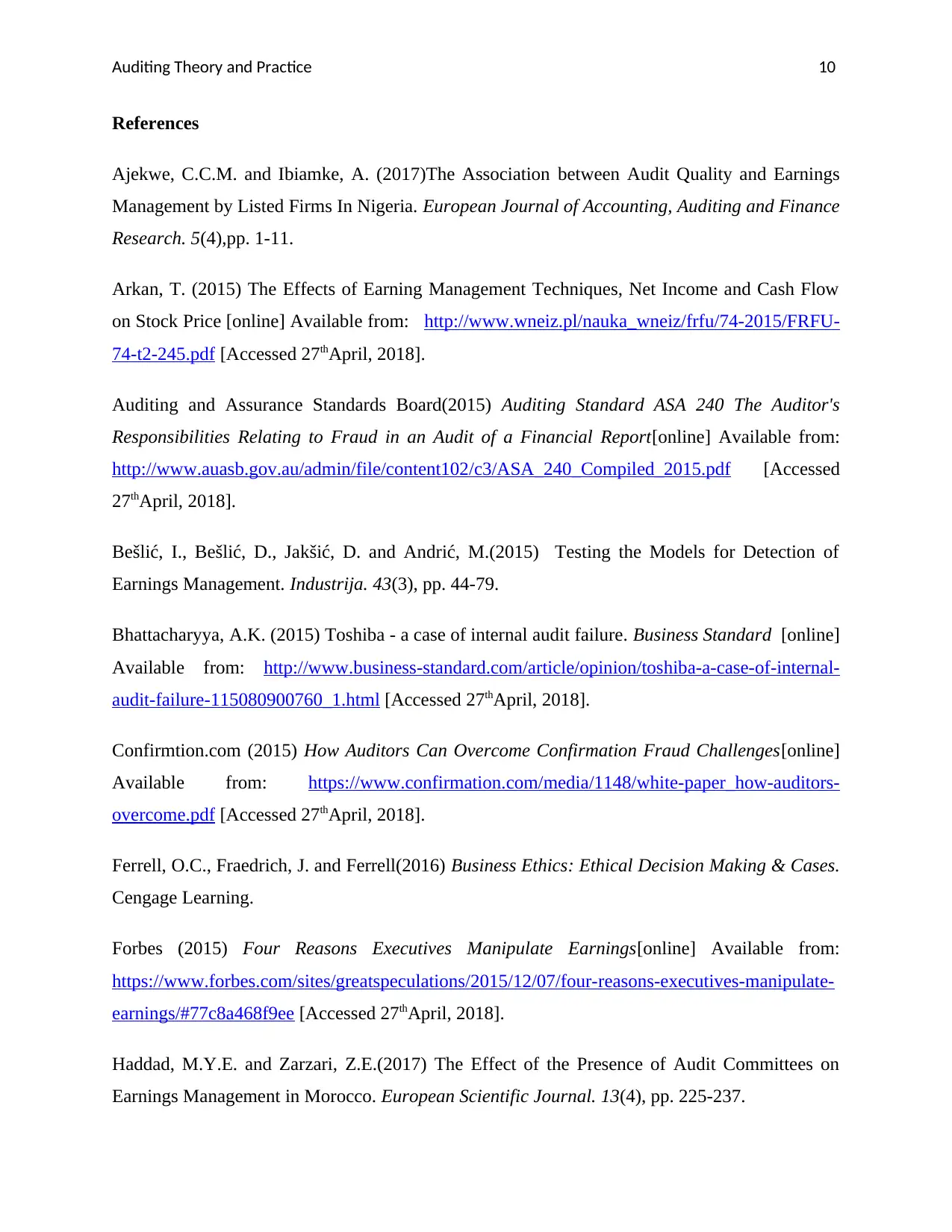
Auditing Theory and Practice 10
References
Ajekwe, C.C.M. and Ibiamke, A. (2017)The Association between Audit Quality and Earnings
Management by Listed Firms In Nigeria. European Journal of Accounting, Auditing and Finance
Research. 5(4),pp. 1-11.
Arkan, T. (2015) The Effects of Earning Management Techniques, Net Income and Cash Flow
on Stock Price [online] Available from: http://www.wneiz.pl/nauka_wneiz/frfu/74-2015/FRFU-
74-t2-245.pdf [Accessed 27thApril, 2018].
Auditing and Assurance Standards Board(2015) Auditing Standard ASA 240 The Auditor's
Responsibilities Relating to Fraud in an Audit of a Financial Report[online] Available from:
http://www.auasb.gov.au/admin/file/content102/c3/ASA_240_Compiled_2015.pdf [Accessed
27thApril, 2018].
Bešlić, I., Bešlić, D., Jakšić, D. and Andrić, M.(2015) Testing the Models for Detection of
Earnings Management. Industrija. 43(3), pp. 44-79.
Bhattacharyya, A.K. (2015) Toshiba - a case of internal audit failure. Business Standard [online]
Available from: http://www.business-standard.com/article/opinion/toshiba-a-case-of-internal-
audit-failure-115080900760_1.html [Accessed 27thApril, 2018].
Confirmtion.com (2015) How Auditors Can Overcome Confirmation Fraud Challenges[online]
Available from: https://www.confirmation.com/media/1148/white-paper_how-auditors-
overcome.pdf [Accessed 27thApril, 2018].
Ferrell, O.C., Fraedrich, J. and Ferrell(2016) Business Ethics: Ethical Decision Making & Cases.
Cengage Learning.
Forbes (2015) Four Reasons Executives Manipulate Earnings[online] Available from:
https://www.forbes.com/sites/greatspeculations/2015/12/07/four-reasons-executives-manipulate-
earnings/#77c8a468f9ee [Accessed 27thApril, 2018].
Haddad, M.Y.E. and Zarzari, Z.E.(2017) The Effect of the Presence of Audit Committees on
Earnings Management in Morocco. European Scientific Journal. 13(4), pp. 225-237.
References
Ajekwe, C.C.M. and Ibiamke, A. (2017)The Association between Audit Quality and Earnings
Management by Listed Firms In Nigeria. European Journal of Accounting, Auditing and Finance
Research. 5(4),pp. 1-11.
Arkan, T. (2015) The Effects of Earning Management Techniques, Net Income and Cash Flow
on Stock Price [online] Available from: http://www.wneiz.pl/nauka_wneiz/frfu/74-2015/FRFU-
74-t2-245.pdf [Accessed 27thApril, 2018].
Auditing and Assurance Standards Board(2015) Auditing Standard ASA 240 The Auditor's
Responsibilities Relating to Fraud in an Audit of a Financial Report[online] Available from:
http://www.auasb.gov.au/admin/file/content102/c3/ASA_240_Compiled_2015.pdf [Accessed
27thApril, 2018].
Bešlić, I., Bešlić, D., Jakšić, D. and Andrić, M.(2015) Testing the Models for Detection of
Earnings Management. Industrija. 43(3), pp. 44-79.
Bhattacharyya, A.K. (2015) Toshiba - a case of internal audit failure. Business Standard [online]
Available from: http://www.business-standard.com/article/opinion/toshiba-a-case-of-internal-
audit-failure-115080900760_1.html [Accessed 27thApril, 2018].
Confirmtion.com (2015) How Auditors Can Overcome Confirmation Fraud Challenges[online]
Available from: https://www.confirmation.com/media/1148/white-paper_how-auditors-
overcome.pdf [Accessed 27thApril, 2018].
Ferrell, O.C., Fraedrich, J. and Ferrell(2016) Business Ethics: Ethical Decision Making & Cases.
Cengage Learning.
Forbes (2015) Four Reasons Executives Manipulate Earnings[online] Available from:
https://www.forbes.com/sites/greatspeculations/2015/12/07/four-reasons-executives-manipulate-
earnings/#77c8a468f9ee [Accessed 27thApril, 2018].
Haddad, M.Y.E. and Zarzari, Z.E.(2017) The Effect of the Presence of Audit Committees on
Earnings Management in Morocco. European Scientific Journal. 13(4), pp. 225-237.
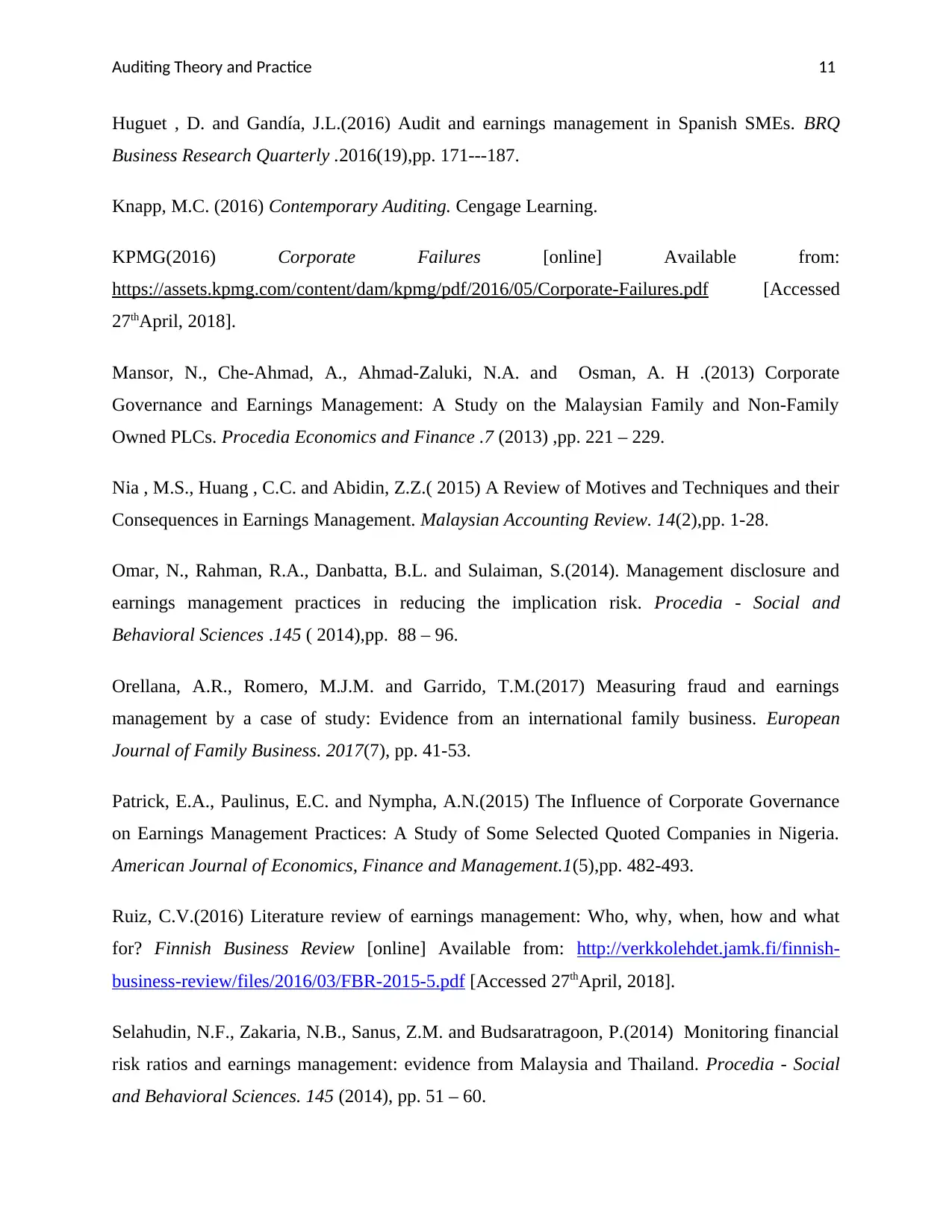
Auditing Theory and Practice 11
Huguet , D. and Gandía, J.L.(2016) Audit and earnings management in Spanish SMEs. BRQ
Business Research Quarterly .2016(19),pp. 171---187.
Knapp, M.C. (2016) Contemporary Auditing. Cengage Learning.
KPMG(2016) Corporate Failures [online] Available from:
https://assets.kpmg.com/content/dam/kpmg/pdf/2016/05/Corporate-Failures.pdf [Accessed
27thApril, 2018].
Mansor, N., Che-Ahmad, A., Ahmad-Zaluki, N.A. and Osman, A. H .(2013) Corporate
Governance and Earnings Management: A Study on the Malaysian Family and Non-Family
Owned PLCs. Procedia Economics and Finance .7 (2013) ,pp. 221 – 229.
Nia , M.S., Huang , C.C. and Abidin, Z.Z.( 2015) A Review of Motives and Techniques and their
Consequences in Earnings Management. Malaysian Accounting Review. 14(2),pp. 1-28.
Omar, N., Rahman, R.A., Danbatta, B.L. and Sulaiman, S.(2014). Management disclosure and
earnings management practices in reducing the implication risk. Procedia - Social and
Behavioral Sciences .145 ( 2014),pp. 88 – 96.
Orellana, A.R., Romero, M.J.M. and Garrido, T.M.(2017) Measuring fraud and earnings
management by a case of study: Evidence from an international family business. European
Journal of Family Business. 2017(7), pp. 41-53.
Patrick, E.A., Paulinus, E.C. and Nympha, A.N.(2015) The Influence of Corporate Governance
on Earnings Management Practices: A Study of Some Selected Quoted Companies in Nigeria.
American Journal of Economics, Finance and Management.1(5),pp. 482-493.
Ruiz, C.V.(2016) Literature review of earnings management: Who, why, when, how and what
for? Finnish Business Review [online] Available from: http://verkkolehdet.jamk.fi/finnish-
business-review/files/2016/03/FBR-2015-5.pdf [Accessed 27thApril, 2018].
Selahudin, N.F., Zakaria, N.B., Sanus, Z.M. and Budsaratragoon, P.(2014) Monitoring financial
risk ratios and earnings management: evidence from Malaysia and Thailand. Procedia - Social
and Behavioral Sciences. 145 (2014), pp. 51 – 60.
Huguet , D. and Gandía, J.L.(2016) Audit and earnings management in Spanish SMEs. BRQ
Business Research Quarterly .2016(19),pp. 171---187.
Knapp, M.C. (2016) Contemporary Auditing. Cengage Learning.
KPMG(2016) Corporate Failures [online] Available from:
https://assets.kpmg.com/content/dam/kpmg/pdf/2016/05/Corporate-Failures.pdf [Accessed
27thApril, 2018].
Mansor, N., Che-Ahmad, A., Ahmad-Zaluki, N.A. and Osman, A. H .(2013) Corporate
Governance and Earnings Management: A Study on the Malaysian Family and Non-Family
Owned PLCs. Procedia Economics and Finance .7 (2013) ,pp. 221 – 229.
Nia , M.S., Huang , C.C. and Abidin, Z.Z.( 2015) A Review of Motives and Techniques and their
Consequences in Earnings Management. Malaysian Accounting Review. 14(2),pp. 1-28.
Omar, N., Rahman, R.A., Danbatta, B.L. and Sulaiman, S.(2014). Management disclosure and
earnings management practices in reducing the implication risk. Procedia - Social and
Behavioral Sciences .145 ( 2014),pp. 88 – 96.
Orellana, A.R., Romero, M.J.M. and Garrido, T.M.(2017) Measuring fraud and earnings
management by a case of study: Evidence from an international family business. European
Journal of Family Business. 2017(7), pp. 41-53.
Patrick, E.A., Paulinus, E.C. and Nympha, A.N.(2015) The Influence of Corporate Governance
on Earnings Management Practices: A Study of Some Selected Quoted Companies in Nigeria.
American Journal of Economics, Finance and Management.1(5),pp. 482-493.
Ruiz, C.V.(2016) Literature review of earnings management: Who, why, when, how and what
for? Finnish Business Review [online] Available from: http://verkkolehdet.jamk.fi/finnish-
business-review/files/2016/03/FBR-2015-5.pdf [Accessed 27thApril, 2018].
Selahudin, N.F., Zakaria, N.B., Sanus, Z.M. and Budsaratragoon, P.(2014) Monitoring financial
risk ratios and earnings management: evidence from Malaysia and Thailand. Procedia - Social
and Behavioral Sciences. 145 (2014), pp. 51 – 60.
⊘ This is a preview!⊘
Do you want full access?
Subscribe today to unlock all pages.

Trusted by 1+ million students worldwide
1 out of 13
Related Documents
Your All-in-One AI-Powered Toolkit for Academic Success.
+13062052269
info@desklib.com
Available 24*7 on WhatsApp / Email
![[object Object]](/_next/static/media/star-bottom.7253800d.svg)
Unlock your academic potential
Copyright © 2020–2025 A2Z Services. All Rights Reserved. Developed and managed by ZUCOL.




